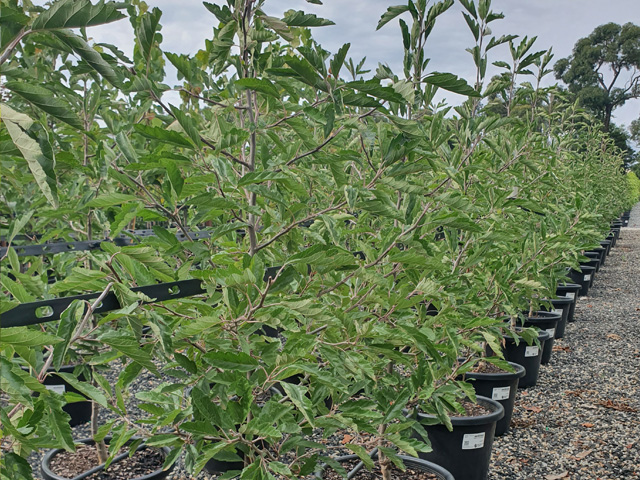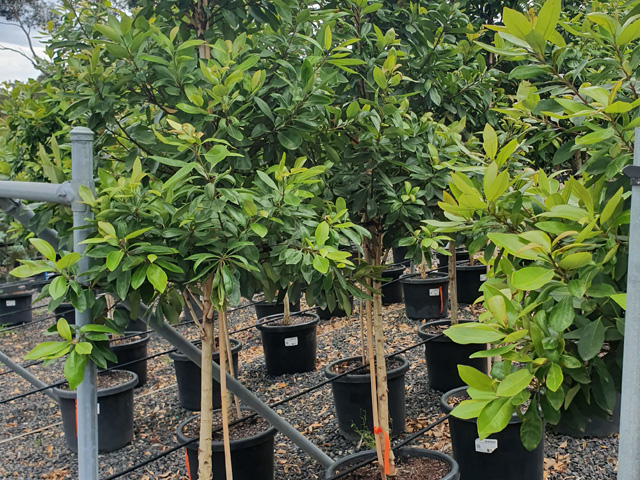THE LOWDOWN ON STREET TREE SELECTION
27 Feb 2020
Taking its toll on the environment and levelling communities, bushfire impact is a major consideration right now. The right trees can help rebuild streetscapes for resilience.

Brachychiton acerifolius x populneus 'Jerilderie Red'
The recent outbreak of major bushfires has once again turned attention to the role of trees in the environment, and community expectations around fire management from a prevention perspective with regard to greening and canopy cover.
As a life devoid of trees is unthinkable and undesirable, we all need to work towards appropriate solutions.
When addressing the requirement for suitable street trees, particularly for planting under power lines, there are a number of appropriate selections to choose from and a number of trees currently under development for this very purpose.  Corymbia citriodora 'Scentuous'
Corymbia citriodora 'Scentuous'
From Speciality Trees’ perspective, there are three key points to consider when selecting trees. All are related, but each needs to be addressed separately to assess the big picture.
1. BUY QUALITY
You get what you pay for. Accredited nurseries charge more for their trees because of the inputs and processes they adopt. These nurseries are audited to guarantee compliance to premium-quality growing systems. From the buyers point of view, this is an investment in the tree itself.
The benefits of great processes are trees with good root systems, which give great anchorage when planted and are less likely to fail and fall within the vicinity of power lines. Trees with a well attached branch structure will also be less likely to lose or drop branches in extreme weather conditions. And, quality trees require less maintenance post planting.  Lagerstromia indica x fauriei 'Zuni'
Lagerstromia indica x fauriei 'Zuni'
2. FORMATIVE PRUNING IS ESSENTIAL
Formative pruning is particularly important with younger trees to ensure a good mature form. Critical decisions that set the tree up for life are made early, including the decision to terminate should form not be good enough or systems not supportive enough for long term growth. Get to know the production nursery and be assured that these practices are in place before you buy.
Be aware of the additional work required when purchasing smaller trees over advanced specimens. Smaller stock will need seasonal pruning to ensure longevity (at least two formative pruning seasons for smaller stock).
If the quality and frequency of post-planting maintenance in the landscape is an issue, advanced specimens greater than 50 litres will be more cost effective in the long run due to less work being required once established — the formative pruning has already been done for you.
Forget the notion that anyone with secateurs can maintain trees. It is about good pruning practices that train the tree to grow in the right way. This is highly skilled work and needs to be done properly by well trained and qualified staff, not the lowest priced contractor. Train your people and/or bring them into the nursery environment for a first-hand demonstration.  Malus ioensis 'Plena'
Malus ioensis 'Plena'
3. PLANT SELECTION IS VITAL
There has been a huge amount of work done over the years in selecting smaller trees for planting in urban environments. These can be utilised under power lines. There are trees that remain under six metres at maturity that can easily be pruned to accommodate wires.
Growing trees true to type is essential if planting in restricted growth zones.  Tristaniopsis laurin DOW10 'Luscious' PBR
Tristaniopsis laurin DOW10 'Luscious' PBR
Below is a list of suggestions that Speciality Trees know will perform well in streetscapes.
NATIVE EVERGREEN
|
Brachychiton acerifolius x populneus ‘Bella Pink’ |
8 x 7m |
A newer grafted selection. Small to medium-sized tree, grafted for compactness. Great for urban situations including streetscapes. Makes a reliable shade tree. |
|
Brachychiton acerifolius x populneus ‘Jerilderie Red’ |
8 x 7m |
A newer grafted selection with a bloated trunk and stunning flowers in summer. This is another tree that would make a good street tree and distinctive signature statement. It is a reliable selection for shade. |
|
Callistemon citrinus ‘Kings Park Special’ |
4 x 2m |
This native small tree is very hardy and adaptable to a wide range of locations and soils. A highly versatile tree for many situations with distinctive red bottle brush flowers, it is generally trouble-free. |
|
Corymbia citriodora ‘Scentuous’ |
7 x 3m |
This fantastic selection has fine leaves, grows to 7 metres in 20 years, remains fully ‘dressed’ with little to no limb drop and has the most magnificent salmon-pink bark. Grafted onto C. maculata this tree will appeal for street tree and general amenity plantings. |
|
Eucalyptus torquata |
6 x 3m |
This is a compact growing, spreading tree to 3 metres. A nice selection for streetscapes and performs best in full sun. Easy to prune and maintain. |
|
Lophostemon confertus ‘ST2’ |
8 x 4m approx |
This is our selection and new to the range. It has a more dense and upright habit compared to straight Lophostemon confertus. It is not overly tall but has an impressive structure perfect for streetscapes. |
|
Tristaniopsis laurina DOW10 ‘Luscious’ PBR |
7 x 3m |
This is a small, tough tree with glossy foliage. Tristaniopsis has been used extensively in Melbourne as a street tree. However, this newer variety with its smaller, more compact form is far more suitable for under power lines. We have found it requires a little effort to establish but it copes with pruning well and provides excellent specimen when mature. |
DECIDUOUS
|
Lagerstroemia selections |
6 x 4m |
These varieties perform well with minimal maintenance although they do respond well to regular pruning. They cope well with a variety of soil types. There are a number of varieties to choose from based on flower colour. We prefer Sioux, Natchez or Zuni as they are more compact trees. |
|
Malus ioensis ‘Plena’ |
6 x 4m |
In the same vein as Lagerstroemia but with more a weeping habit, this deciduous ornamental offers flower and form to 6m which makes it a fabulous small feature tree in streetscapes where height and space is limited. |
For more information on these trees or others you are considering, contact the sales team on 03 9796 8308 or at sales@specialitytrees.com.au
Want to know more? Check out this video on Trees for Streetscapes by Speciality Trees.







